| Home Page |
|---|



In 1872, the tea merchant and shop at number 446 Strand in London had been standing empty for some weeks, possibly months, it had recently been bought by another tea merchant; Twining & Co. Number 446 Strand had been a tea merchants and shop belonging to Edmund E Antrobus, Teaman. Above the shop hung an elaborate sign showing the royal arms, with the name 'Edmund Antrobus, Tea Man to Her Majesty'. It seems that at sixty-six years of age Edmund E Antrobus had decided to merge his business with that of Twining's and set about retiring from the trade in which he had grown-up. He would go on to live until 1886, but with no son or siblings to pass the business onto, Edmund seems to have decided the future of the business lay with another tea merchant. In doing so he brought to an end a business which had been running continuously, at several addresses, on The Strand since at least the middle of the 18th century. For over a century this tea business had been a supplier of teas and medicines to the royal household.
Edmund E Antrobus, the last proprietor of the Antrobus tea business on the Strand, was descended from the Congleton branches of the Antrobus family, in the ancient parish of Astbury. In the 17th century the Antrobus family were yeoman farmers in Od Rode of that Parish. Then there had been little to indicate that some-one from this northern family would become a major druggist and tea merchant. The important connection that led to the Antrobus family being involved in the tea trade in London was a family link that started with a marriage between the Antrobus family and a Huguenot family called Sanxay over a hundred years earlier. The Sanxay family resided in The Strand in London and also had a country home in Cheam, a parish then neighbouring London. Although there were members of more distant branches of the Antrobus family already resident in London at least from the beginning of the 16th Century, the Antrobus family of Od Rode near Congleton had few links to London before their connection to the Sanxay family. The nearest relation from Congleton that moved to London was a Thomas Antrobus who lived in Hackney. He was a grandson of Edmund Antrobus of Od-Rode and was a cordwainer (shoe maker) and as such may have had links with the London based Huguenot society. He died in 1713 having possibly established a connection between the two families, but this can only be speculated on. Therefore exactly how the two families became known to each other remains uncertain. A better possibility is they became known to each other through the cloth and silk trade. The great grandfather of Edmund E Antrobus was Philip Antrobus of Congleton, a dyer, and it is known that at the end of the 17th century Huguenots arrived in Macclesfield. These " ingenious strangers", as they were called, were encouraged to bring their weaving skills to Macclesfield by the town's leading citizens to help invigorate the silk industry, then still in its infancy in Cheshire. A small community of Huguenots settled in Macclesfield. On the 24th November 1711 the sister of Philip Antrobus married a Daniel Sanxay of Cheam. Daniel Sanxay had been brought to England by his father, Jacques Sanxay, when he was a child to escape the persecution of protestants by Catholic France. Although the Sanxay family themselves were not weavers and resided in London and Cheam, the Sanxay's probably had extensive Huguenot connections through the commerce and industry of London, and no doubt Philip Antrobus and others in the Antrobus family needed to travel to London as part of that industry.
Something is known of the history behind the arrival of the Sanxay family in England as refugees in the 1685. The Sanxay family were well to do merchants who lived in Taillebourg, a small town in the Poitou-Charentes region of France. Jacques Sanxay parents are thought to have been the well to do merchant Josué Sanxay and Marie Vivier. There were also wider members of the family living nearby in Saintes. Pastor Jacques Sanxay went into the church having been educated initially at the Jesuit College in Bordeaux. He had shown such talent and learning in his studies that he had won a prize awarded for eloquence and the Jesuits there tried to persuade him to join their society, which resulted in his father withdrawing him from that college. He was sent to London to learn English and of the ways of business. When his father died two years later Jacques Sanxay returned to France showing little taste for business and entered the protestant college at Saumur, after which he entered into the orders and became Pastor of the church at St. Jean D' Angle. At the time when Jacques Sanxay and his family were forced to leave France, when the Revocation of the Edict Nantes in 1685 was issued, he was Pastor of Tonnay-Boutonne. The persecution of the Protestants had already been severe in the south west of France for the year leading up to the issue of the Revocation order or Edict. Jacques Sanxay had already been imprisoned at the La Rochelle prison for some six months before the Edict was actually issued. This ordered all protestant ministers to either withdraw from their protestant faith or leave France in fifteen days. Those that refused were threatened with imprisonment, or rather enslavement, on the Galleys. It was on these terms that Jacques Sanxay was released from his original imprisonment on the orders of the Duke of Bouffles with the condition that he would quit France in fifteen days. He had been imprisoned due to his earlier refusal to close up his church and desist from preaching. Thus he was released with fifteen days to dispose of all of his belongings and raise the funds to pay for his family's passage to England. Not that there was much left at his house to take as during his period of imprisonment dragoons had been quartered there and they had helped themselves to most of what was there to be taken. When the fifteen days was up he still had not found a ship that would take his family to England, and he was forced to take a ship, the 'La Montagne de Liévre' captained by a Robert Simon, bound for Rotterdam Holland. The ports at La Rochelle were being closely watched at the time and Jacques Sanxay had no choice but to take that ship with others in similar plight. As the ship was leaving port public officials boarded her to closely inspect the Sanxay's passport papers to ensure that 'all was in order'. Fortunately they made no trouble for the Sanxay's and on the 20th November 1685 the Sanxay's left their homeland on a ship embarked for Holland. However as fate would have it a storm of extra-ordinary force blew the ship off course and it was driven towards the port of Plymouth. And so Jacques Sanxay and his family found themselves on England's shores. They disembarked at Plymouth, refugees fleeing from persecution and with most of their worldly possessions lost.
The Sanxay family stayed for a period with a family called Jonkin in Cornwall, but in time Jacques Sanxay and his family eventually settled in Exeter where he was offered the post of pastor of an ancient Saxon church in called St. Olave's on Fore Street. This Church had been given over to the Huguenot refugees. During this period there was a sizeable Huguenot community resident in Exeter and Jacques was welcomed to minister to their needs. Here he also found many of the friends and colleagues he had known in France, friends of his father and of the Sanxay family. Shortly after his arrival in Exeter William, Prince of Orange, also landed in England close by and he passed through Exeter on his way to London to claim the crown. His arrival signalled the supremacy of Protestantism in Britain. Maybe, thanks to his refugee status and their shared faith, he met the price during his stay in Exeter. Jacques Sanxay lived out the rest of his life in Exeter and died suddenly in 1692. His daughter, Claudia, suspected poison by a French person acting as a spy. The Frenchman had drunk coffee with the pastor the day before his death. It was thought that the French government was suspicious of the large number of protestant pastors from France, suspecting that they were supplying the newly crowned William of Orange with details of France's coastal defences.
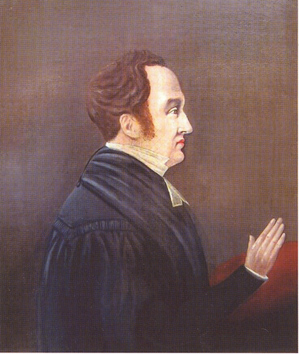 Rev Daniel Sanxay, married Jane Antrobus, father of Robert Sanxay. Courtesy of Cheam School.
Rev Daniel Sanxay, married Jane Antrobus, father of Robert Sanxay. Courtesy of Cheam School.
Daniel Sanxay, the elder son of Jacques Sanxay and who married Jane Antrobus, the sister of Philip Antrobus of Congleton in 1711, was born in France and would have been about seven years of age when he arrived in England. He and his younger brother went on to be educated at the New College, Oxford where he trained as a clergyman in the Church of England and received an MA in 1703. Daniel then moved to Cheam where he settled, he would become the head of the school at Cheam in the same year of his marriage. Daniel Sanxay and his family were not the only members of the Sanxay family who moved to the area in and around Cheam and London. His Niece, Charlotte, married Benjamin Bradley, the first partner of Robert Sanxay the druggist, Daniel's third son. Other relations also moved to the area and by the latter half of the 18th Century many of the Sanxay family had established themselves in business in London.
Philip Antrobus of Congleton, the dyer, probably had business connections with the Huguenot cloth and silk workers and through them met The Rev Daniel Sanxay of Cheam. However they met, Jane Antrobus and Daniel Sanxay were married in 1711. There were to be a further two marriages between the Antrobus and Sanxay families as two of their children would marry into the Antrobus family of Congleton and Od Rode, ensuring there would be a link that would last several generations. Many of the extended Antrobus family of Congleton would take advantage of this London connection and take the opportunity to move down to Cheam. This connection would open opportunities that would otherwise not have been so readily available, allowing several Antrobuses to break into trades in London where they could find greater opportunities for prospering.
The business that would eventually become known as Edmund Antrobus - Tea man to his majesty - was founded by a son of Daniel and Jane Sanxay called Robert Sanxay. Daniel and Jane Sanxay had seven children. Robert Sanxay, their third son, became a highly successful druggist such that he was granted a royal warrant to supply medicines to the royal household and became the druggist and also tea man to King George the second in 1760. He was born in 1716 and by 1754 had established a successful druggist business. He already would probably have sold some teas as this was considered a health beverage. Tea was well established in England by the middle of the eighteenth century, the first tea houses opened in London in the 1650s. Robert's place of business was on the Strand, just opposite Craven Street and the great Northumberland House, near the present Charing Cross Station, number 476 on the Strand.
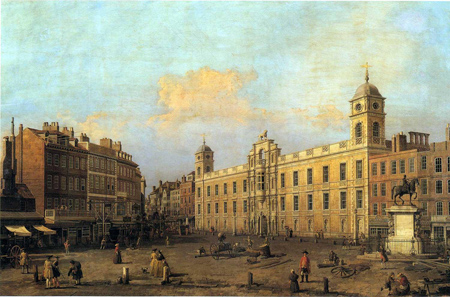 Charing Cross facing the Strand and Northumberland House about 1760, Robert Sanxay's druggist business would be on the left corner of the Strand entrance
Charing Cross facing the Strand and Northumberland House about 1760, Robert Sanxay's druggist business would be on the left corner of the Strand entrance
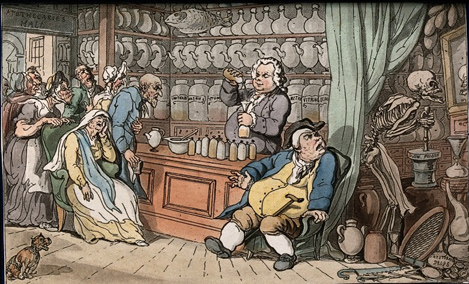 Satirical eighteenth-century image of the druggist
Satirical eighteenth-century image of the druggist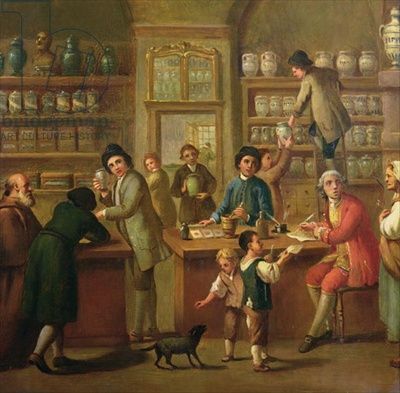 The selling of teas and coffees, select your tea from behind the counter, the clerk logs it in the sales book
The selling of teas and coffees, select your tea from behind the counter, the clerk logs it in the sales book
It is not known when exactly John's younger brother, Edmund, also became a partner in the tea business; he probably had a lesser involvement before the death of Robert Sanxay. However we do know that by 1786, thanks to the correspondence between him and Edmund Antrobus, the banker with Coutts and Co, Edmund is referred to as a tea Merchant and therefore must have been at least associated with the business at the time of Robert Sanxay's death. However John Antrobus seems to have brought in a new partner within a few years after Robert Sanxay's as the London directory of 1783 shows that his business house is now called Antrobus & Seaman, druggist's, 476 the Strand. Unfortunately nothing more seems to be known about John's partner, Mr Seaman. However, the name of the business indicates that John's brother, Edmund, may still not have been a partner in 1783, or at least not a full partner. It seems Edmund still worked with his brother in some capacity as the two brothers continued to provide the banking service started by their uncle, Robert. This seems to have been a mild form of banking where the business agreed to hold their client's money. However, later directories between 1894 and 1800 show the name of the business house during this period is called Antrobus Seaman & Antrobus Tea-Man to His Majesty. It is also interesting to note that the address of the business house has now changed from number 476 to No. 480 Strand. The exact date of this move is not known, but it probably occurred sometime between 1783 and 1786 as the Lowndes's London directory of 1786 shows the address of the tea house as 480 Strand, a location still on the corner of Charing Cross.
In the latter part of the eighteenth century the druggist side of the business seems to have waned and instead tea became the main source of trade. In the latter years of his life Robert Sanxay seems to have been referred more as a "Tea-man to his Majesty" rather than "druggist to his Majesty", in the house hold list of his majesty. After his death his place was taken by his partner, John Antrobus, and we can see in the Almanac for the year 1800, John Antrobus is listed as Tea-man to his Majesty. The tea business continued to hold the royal charter to supply tea to the royal household as it had done since it was awarded to Robert Sanxay in the year 1760. It was now John Antrobus who was included on the list of those in George the Third's household. Hanging outside the Tea House was the elaborate sign with the design "Teaman to his Majesty" braided across it. The popularity of tea continued to grow through the later part of the eighteenth century, especially as the customs tax on tea had now been considerably reduced, and the business was ideally located in the middle of London, business continued to thrive. In those days all tea was imported from China, and transported to Britain by the East India Company, a company that grew incredibly wealthy importing Teas and Spices and all sorts of other goods from the East. The company grew so big it literally became the world's first truly global trading company. Investing in tea was an expensive and long term business as a round trip for an East India company ship (usually called simply "East Indiamen") at the beginning of the 18th century could be as long as two years. East Indiamen were usually big, heavily armed vessels that would sail in conveys for safety, journeys across the globe to India and China via the Cape of Good Hope could be dangerous, in those days the sea were infested with pirates and hostile warlords looking to capture valuable cargos. Hence the heavily armed convoys of ships packed full with their cargos could only travel very slowly. As tea merchants John and Edmund would have dealings with the East India Company, regularly visiting the sales rooms at East India House on Leadenhall Street to barter for the best prices.
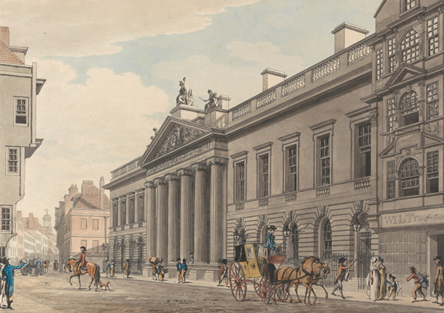
Edmund demonstrated his readiness to provide assistance where he was able to exercise influence with the East India Company, and also keep in contact with those he had previous contact with, he was again able to help Thomas Addison, midshipman, in 1803, as he write is his journal:
The tea business was not the only connection the Antrobus family was to have with the Honourable East India Company (HEIC). John and Edmund's cousin, Thomas Antrobus, a younger brother of Edmund Antrobus the banker with Coutts & Co., also joined the East India Company. Thomas Antrobus obtained a position of Writer in the company, thanks in some part to the influence of Thomas Coutts the banker. The position of writer is actually one of the lower positions (the post was eventually reformed and retitled as "civil servant"), but in order to enter HEIC he first had to take and pass the necessary exams and supply adequate references. A letter of reference from Thomas Coutts states that Thomas Antrobus had gained considerable experience in his employs at his counting house and was a master of book keeping and merchant accounts. In due course Thomas Antrobus was appointed to the position of Writer at Fort St. George in India (known later as Madras) in 1781. Thomas Coutts was a good friend of George Macartney, Lord Macartney, who went to India to take up his posting as governor of Fort St. George at the same time as Thomas Antrobus was shipped out. Using his influence with Macartney, Coutts urged him to give Thomas Antrobus a posting in his household to help him gain a better position in time. Correspondence between Coutts and Macartney between 1781 and 1784 shows that Macartney had placed Thomas Antrobus on his household staff, and that he was satisfied with his performance. The Records of Services of the East India Company published in 1885 show that in 1783 Thomas had been appointed assistant to the secretary to the select committee. It seems however by this time Thomas was suffering from bad health as the records then show that in late 1783 he was on leave to china for health, and that he is not traced after 1784. There is a tradition that Thomas was sent to China to begin discussions for an embassy to be sent to the emperor of China to open up more trade with the East India Company. His death in 1784 left some uncertainty as to whether he died in China or India. Coutts letter to Macartney in August 1784 expresses his regret on hearing of his death but makes no mention of where he died. A later decedent of the family, Rev Jocelyn Antrobus, states that he is buried on the Shameen in Canton. If so then perhaps there is a small patch in China that is forever England.
Both John and Edmund Antrobus seem to have married late in life. However Edmund seems to have caused something of a scandal by having a child born out of wedlock, something that would have been considered a serious stain against his character. He had a son, Edmund Edward Antrobus, by Ann Rogers in the year in 1806. Little is known about Ann Rogers except that she was born in 1777 and died 18th November 1835. Edmund did eventually marry Ann Rogers on 5th November 1814, a year after his brother's death, he would then have become the principal partner of the tea business. John Antrobus finally married in 1809, at the age of fifty eight; he married a widow from the town of his birth, Congleton, she was called Charlotte Bence. Her maiden name was Vardon, of a well-established Congleton family and one that was already closely linked by marriage with the Antrobus family. Her first husband had been Isaac Bence whom she married in 1794. John and Charlotte Bence were married in Congleton, in the ancient parish of Astbury on 14th February 1809.
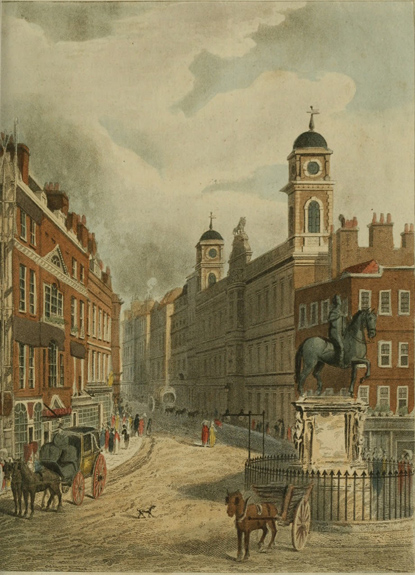
An example of Edmund's continued involvement with the tea business is shown by his being one of those tea merchants who attended the monthly sales of tea at East India House on Leadenhall Street. In 1818, directly after one such monthly sale, Edmund Antrobus was appointed to a committee formed to choose a deputation to attend to the board of excise. The function of this deputation was to the learning as to what extent the practice of adulterating tea had come to their knowledge and what seizures of this adulterated had been made. The committee met the next day after the monthly sale, Mr Twining of Twining & Co. was appointed as Chairman. Adulteration of tea was much more extensive than the board of excise cared to admit. This could have meant that most tea sold could be adulterated - a dangerous and dishonest act where tea had been diluted with additional substances such as charcoal, ash or even coal dust, or indeed something even more harmful, to in order to increase its volume and make more profit. The majority of Tea houses and grocers were extremely fearful that the tea they were selling could be poisonous. Thus it was hoped that the committee would be able to establish if adulterated tea was being seized and prevented from being sold on the open market. Although a law against adulteration was passed in parliament in 1776 it was not compulsory and the practice still continued (indeed it is a practice that is known to go on today). The adulteration of tea was taken very seriously as tea was still being sold for its presumed health benefits. Most adulteration of tea was said to occur at its source, which, in 1818, the supply of all tea was from China. Tea sellers in Britain blamed all adulterations of tea as occurring outside the country and blamed its import on customs and excise for not checking all tea thoroughly on arrival. It was not until the parliamentary Act of 1875 that inspection and analysis of imported foodstuffs became compulsory; this Act won the support of all traders and industry because of its emphasis on "outside" contamination.
In 1822 Mr Green of Antrobus & Green died, in Kent's directory in 1823 the firm is still called Antrobus & Green, after this the firm seems to have traded under the name Edmund Antrobus (Late Antrobus & Green).
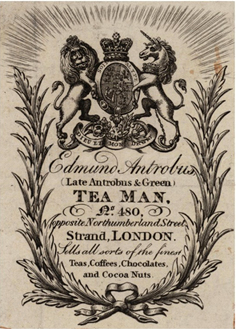
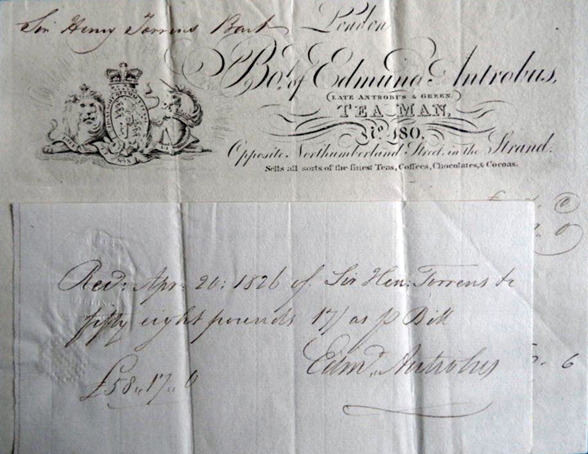
We can learn something of the day to day running of the Tea house business of Edmund E Antrobus thanks to house of commons enquiry into duties attended to by Edmund E Antrobus. On the 9th May 1833 he was called before the commissioner of Excise to answer some questions about his business. He confirms he is a tea dealer on the Strand, but only in retail rather than in a wholesale tea dealer. He also confirmed that the business was over one hundred years old. Each room in which tea is stored has to be numbered and he is required to have a permit with all teas that come into the house and he must have a license to sell tea. By an act of parliament, as a tea house retailer, he must keep a debtor and credit account that distinguishes between black and green tea. Each time tea is brought into the house the weight of the tea is entered in a stock book for which the permit is drawn up, unless the weight is six pounds or under, in which case the quantity is entered into the 'small' book. Tea sold at the counter is entered into a cash book and so on. Every twenty-eight days an exciseman takes stock and regularly checks the accounts. The commission asked Edmund if his books always balanced or correspond, to which Edmund replied they most certainly did not, they were always down, something that was impossible to avoid in a large retail shop. He explained that these loses are due to small amounts not been logged in the books due to accidental omission or other reasons. However the exciseman allows for one pound of tea loss per chest or box of tea as allowed by the East India Company. Having now established how Edmund regulates his business the commission now turn to the subject of smuggling by asking Edmund if keeping stock and drawing up permits helps prevent the sale of smuggled tea? To which Edmund replied in the negative, saying if a dealer were inclined he might omit to enter all small quantities as he is not compelled to draw up permits for such quantities. Further questioning reveals that Edmund employs porters to take delivery of stock and deliver parcels of tea to customers. He also employs clerks to keep the books and keep stock records up to date. Also the permit offices close at five o'clock in the evening during winter, and at seven in the evening during the summer months. Asked if the excisemen check parcels being carried by porters to see if they are really carrying tea, Edmund replies that excisemen had not checked parcels for ten or fifteen years, because they were wrapped and sealed. The lowest price of teas was the lowest Twankay green tea sold at 5s 4d per pound (5 shillings and 4 pence per pound).
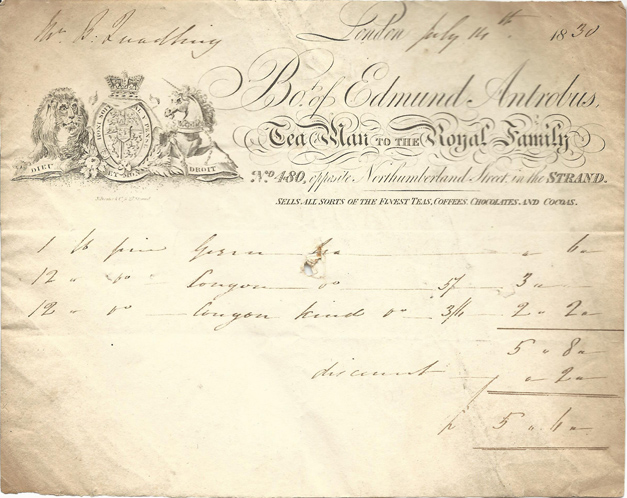
Tea had been a thriving business all this time in Britain but there was always concern about the reliability of the source and therefore the price of tea. The only known source of tea had always been China and there were those who were keen to try and find a way of breaking this monopoly and hold on such a lucrative Trade. Until such a means was found, all tea sellers and merchants were reliant on China, a country that still identified and referred to the British as barbarians and were prone to suspending trade at a moment's notice. With increasing numbers of ships involved in the China trade tea was becoming ever more affordable by the end of the eighteenth century, there were now teas that the poorest people could afford with common black or "Congou" tea and common green or "Twankay" tea increasingly available. Concerns that the supply of such an increasingly popular beverage could be brought to a halt at any moment could only grow as demand grew. The tea industry was not just an English commodity by the nineteenth century; it was fast becoming the world's first truly global commodity. Attempts were made from the late eighteenth century to try and grow the tea plant in various parts of the world, in both Asia and the new world, but all had failed. With the discovery in 1823 of wild tea plants that were growing in some remote parts of Assam in India by Major Robert Bruce, another attempt to introduce the Chinese tea plant to this region was made. The work was done using experts in the nurturing of the plant from China, this time the china tea plant was finally grown successfully outside of China. It was decided, initially, that the "Genuine plant from China" should be grown in Assam instead of the local plant to produce the first tea grown in quantity outside of China and then shipped in one hundred boxes to Britain.
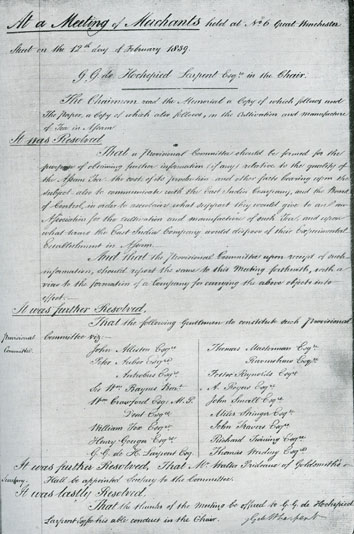
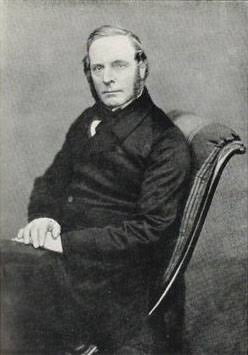 Major Robert Bruce, credited with discovering the Assam tea plant for the East India Company
Major Robert Bruce, credited with discovering the Assam tea plant for the East India Company
Once the investment had gone into producing Assam Tea in large quantities it was found that the costs of establishing areas for the large scale cultivation of tea were much higher than had been expected, and the next auction did not bring in the expected profits. And then an opium war erupted which seriously disrupted trade, preventing the required Chinese expertise from reaching Assam to instruct on the methods of large scale tea cultivation, and risking the company making a loss.
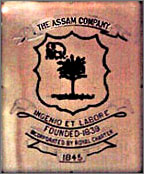
It is probably due to the shaky start of the Assam Company that there seems to be little further mention of Edmund E Antrobus being involved with the company, or at least directly. It is assumed he is one of those who made a contribution to finance the establishment of the company but of his continuing involvement there is little as yet that is published. A full history of the Assam Company was written by another Antrobus; see "History of the Assam Company 1839 - 1953" by Hinson Allen Antrobus
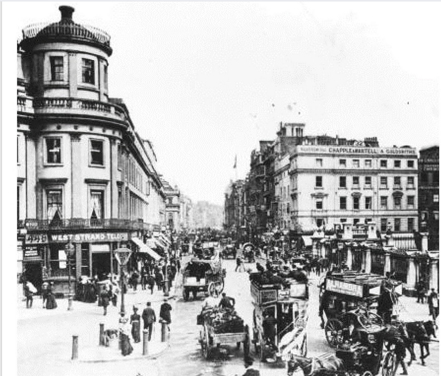 The Strand in the 1890s. No. 446 Strand as just down the road on the left, it would have looked very similar when Wilkie Collins joined the firm.
The Strand in the 1890s. No. 446 Strand as just down the road on the left, it would have looked very similar when Wilkie Collins joined the firm.
During the whole period Wilkie was apprenticed at Edmund's tea house he did not really take to the tea business and would often spent his time 'tale writing'. When Edmund caught him in the act of writing his tales he would quickly find him a new task to occupy him. Edmund does not seem to have tried to over exert his apprentice and allowed him to go on regular holidays with his parents. However Wilkie longed to find a position more suited to his writing skills. Seeing that his son was not taking to mercantile work, his father wrote to his friend, Robert Peel, who had lately become Prime Minister, if he could find Wilkie a civil service position. Peel was not able to help due to the high demand for such postings. William continued to look for alternative positions for his son for the whole time he was working at the tea house. In Later years Wilkie Collins seems to have made one of his novels a semi-autobiographical that included some descriptions from his experiences at the tea merchants. In this novel, called "Hide and Seek", the father of the main character called Zack sends him to work for a counting house: 'My son requires the most unremitting parental discipline and control' remarks the father, and in order to manage his sons "discipline and moral and religious training he is placed in the counting house of a good friend. The character has a friend who is sent unwillingly to work in a tea brokers much like Wilkie Collins, and some of the work is described - "working in a merchants office when I could not do his multiplication tables... Going to filthy places like St. Mary-Axe to take samples, with a blue bag to carry them in, and a dirty junior clerk; who wears Blucher boots and cleans his pen in his hair, to teach me how to fold parcels."
Wilkie's time in the Antrobus tea firm, his "prison on the Strand", seems to have ended acrimoniously. After working almost five years in the business in May of 1846 Wilkie seems to have left on bad terms with Edmund Edward Antrobus. It seems that Wilkie had understood that he would be paid an annual salary of £200 but that: "Old tea bags" has reneged on his promise - as a result there was now "A mighty feud henceforth and forever between the houses twain of Collins and Antrobus" Shortly before leaving Wilkie Collins had started work on his first full novel which he described as "a novel of the most wildly impracticable kind, on the subject of savage life in Polynesia, before the discovery of the group of islands composing that country by civilized men." The novel was called Ioláni and of all his novels it was never published in his lifetime, not until 1999 after the manuscript had been presumed lost for over one hundred years. He went on to study law at Lincoln's and write many more novels which are still in publication today.
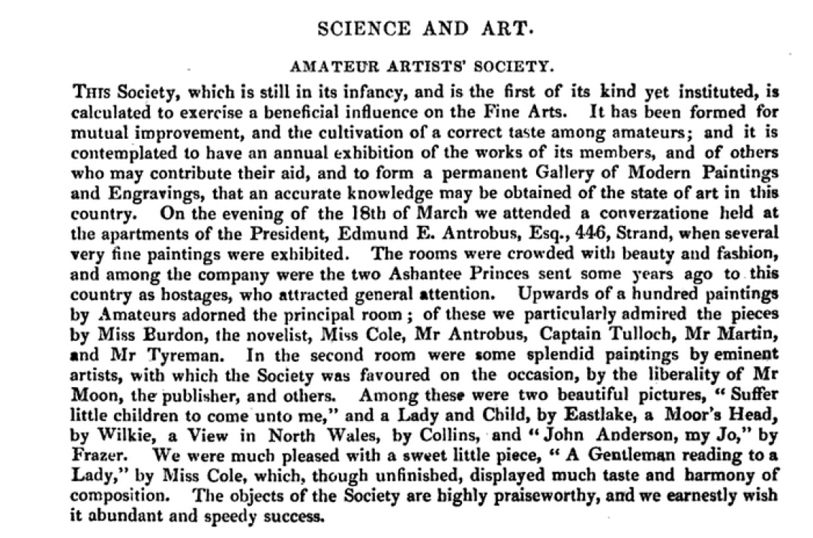
The business seems to have gone under the name 'Edmund Antrobus, teaman to his majesty' for the time Edmund E Antrobus was the proprietor of the business, the name being carried on from the end of his father's time. Often certain articles that mention the tea house at this time tend to refer to the business as Antrobus & Co., this would appear to be somewhat inaccurate as he had no partners during the forty five years of his stewardship over the business. The Antrobus tea business came to an end in 1872, with Twining taking over all the business connections of the house, including the royal warrant to supply tea to the royal household. Below is the front page of what could be the last bill of sale of the Antrobus tea business on the Strand, the original copy is held in the Twining archives.
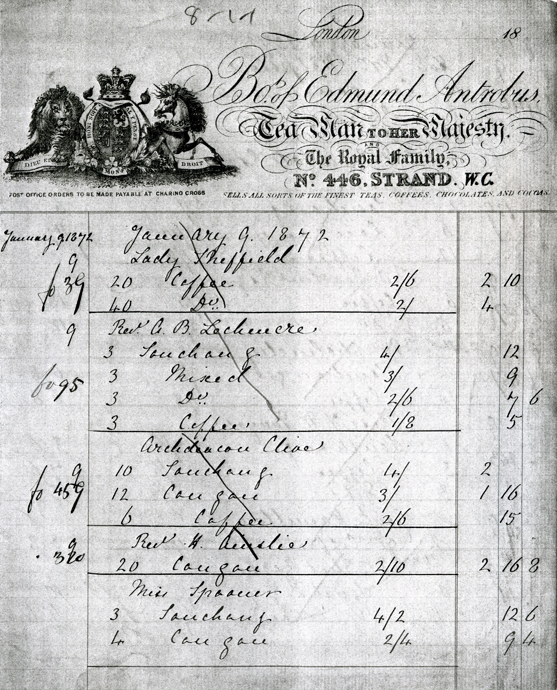
The above list of sales for January 1872 shows one of the last, if not the last, sales made by Edward E Antrobus. This record is from the Archives of R. Twining & Co. Edmund lived until 1886 and does not seem to have involved himself with any of the connections that were transferred to the Twining Company after 1872. He appears to have spent the rest of his life in retirement bringing to an end the Antrobus connection with tea on the strand.